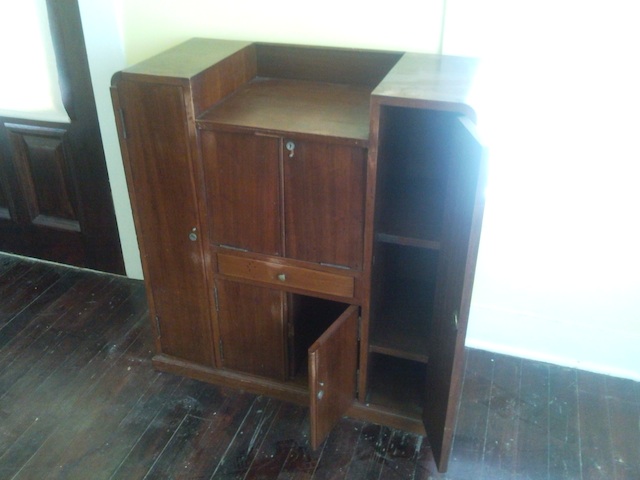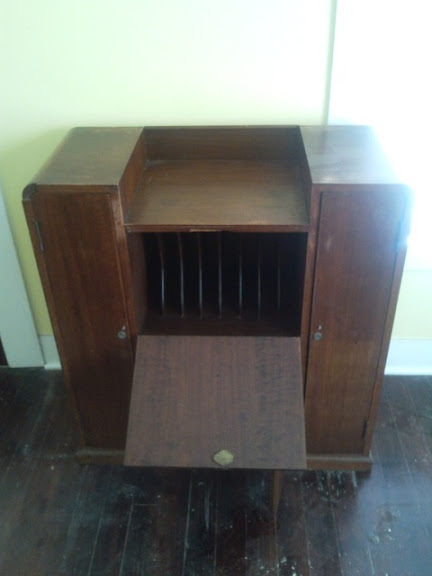It's definately intended for record storage & for an electric phonograph to sit on top. The cabinet is in the Art Deco style, and could date from around 1935 through to the late 1950s. It's a fairly plain deco cabinet, so I would say it was probably made in the 1945-1955 period, but that's based on what was available here in Australia, so in USA it might have been produced a little earlier. Usually earlier cabinets would be a bit more decorative, have contrasting veneers often featuring some sort of geometrical inlay design.
A lot of electric record players did indeed have a similar footprint to earlier acoustic machine, mostly because 10" & 12" turntables & records were the standard, and therefore often had an influence on a phonographs overall size.
Many record player in the Art Deco period were just a cabinet with a turntable & tonearm, and didn't even have an amplifier or speaker built in. This type of player was usually designed to be plugged into a families existing console tube radio so records could be reproduced electrically through the radios amp & speaker/s.
Cabinet holes for electrical leads were not common in this period, and usually the leads would simply hang over the back ledge of such a cabinet and would be hidden from view by the height of the phonographs cabinet itself.
There were also similar record players available during this time that did not need leads to connect to a radio, but instead had a built-in transmitter. These wireless record players would transmit a signal on the AM/MW band, and you could tune into this signal just like a radio station, & you could listen to your records wirelessly through your wireless

Then there were also phonos & phono-radio combinations with built-in amp & speaker available too.
Cabinets like these usually sell for $100-$200 over here, but I'm sure they're far cheaper in USA.
The cabinet pictured above appears to be done in either Australian (Queensland) walnut veneer or mahogany, both of which were commonly used veneers for radio & record player cabinets in USA, UK & Australia.
It's a little hard to tell from the photos, but it also appears that the veneer from the centre drawer may have been removed & the cheap base wood is now the face of the drawer.
That's not a huge deal because you can still get new veneer for a very reasonable price to fix it, however refinishing the new veneer to match the original finish on the rest of the cabinet will be almost impossible, so the whole cabinet would need the old lacquer stripped off it, and a new finish applied so everything is a uniform colour & sheen.
This of course all effects it's current retail & future resale value, and unless you can do a good job of it yourself, it can often cost more than such cabinets are currently worth to have a professional french polisher/furniture restorer refinish it for you.
Then again, it could also be a cheap timber such as pine, that has been stained and varnished, or it could even be a painted faux woodgrained finish. The photos aren't really clear & detailed enough to be 100% sure.
I'd also examine that forward falling door on the inside for any holes that may have been filled, as normally I'd expect to see 1 or 2 metal support rods or brackets of some type, which stopped the door falling past level. They would also allow the door to support the weight of a record album, or give you a surface to place a record for cleaning with a record duster before you placed the disc on the turntable.
Personally, I'd be more than happy to pay $100 for that cabinet as it stands, but as I said, pricing in USA is very different to here in Australia.
I think my little Collaro would look great on that cabinet, though either of the HMV's would look pretty cool too






